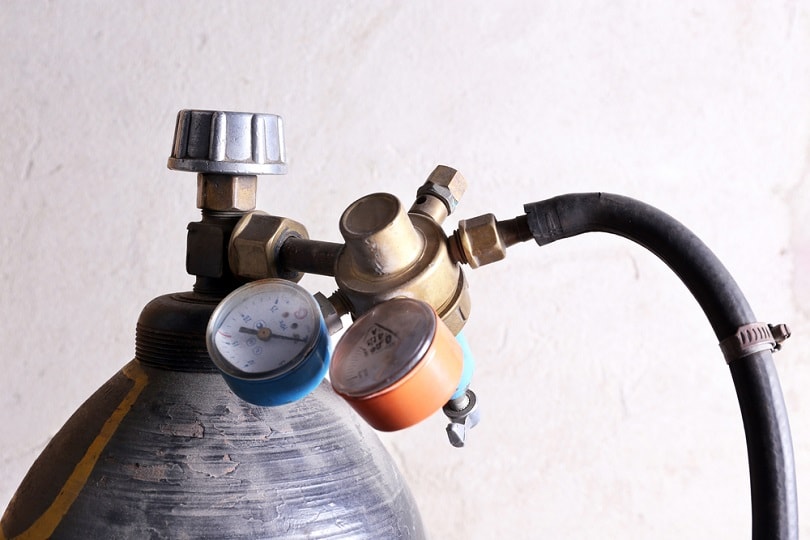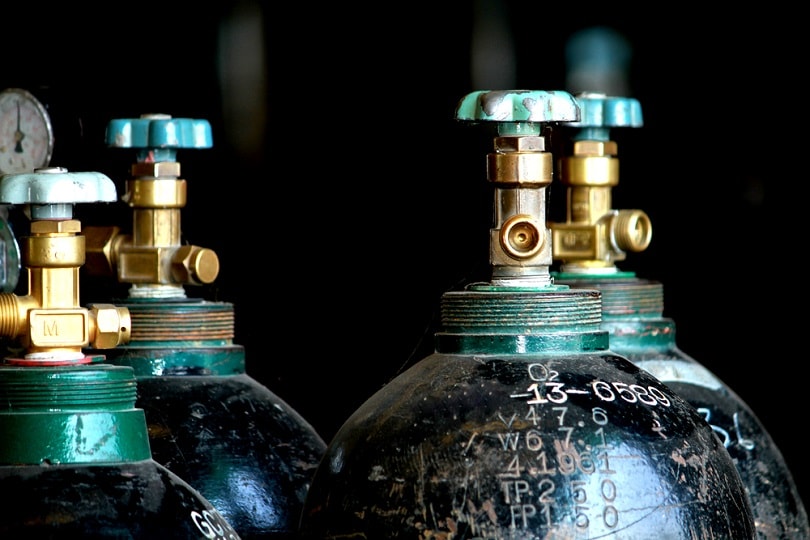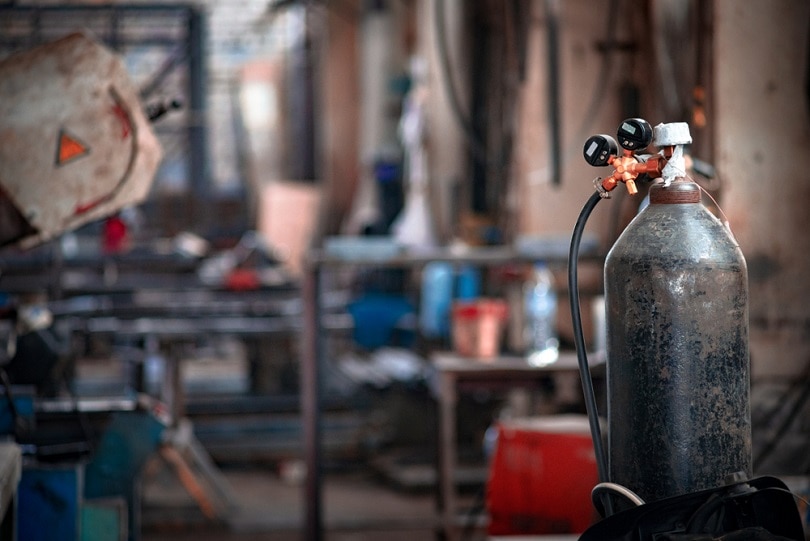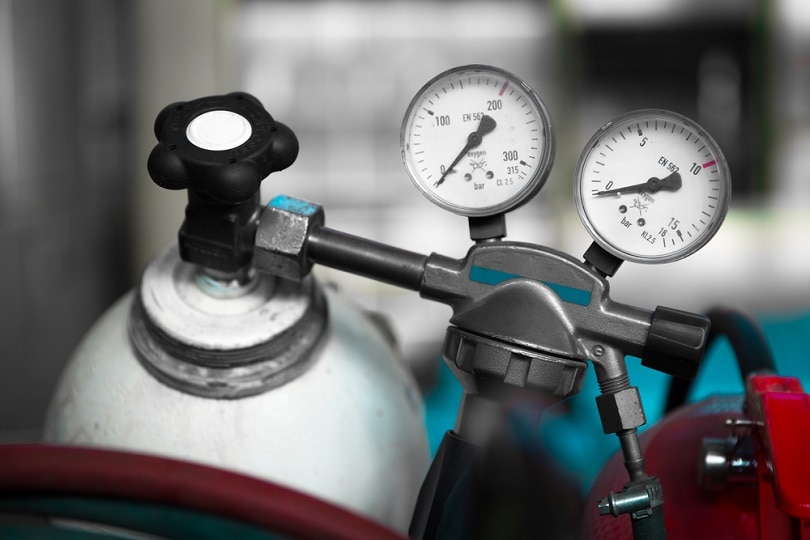Where to Get Welding Gas & How Much Should You Pay? (2024 Update)
Last Updated on

In past decades, stick welders did not have much information about gases with regards to welding. This whole concept changed with the invention of TIG and MIG welding machines and their constant rise in usage. Gas is now considered a common commodity in most welding workshops. But how much does welding gas cost? If you’re just setting up shop, you’ve come to the right place. We’ll break down where to get welding gas and the costs associated with it.
Where to Get Welding Gases
Welding gases can be outsourced from various vendors depending on your location and the type of gas you require. Most vendors provide the option of free delivery for local orders and charge a few bucks for regional deliveries.
The Uses of Welding Gas
Welders use welding gases for several reasons, with the main one being shielding the arc from impurities such as dust. Gases are also used to heat metals during welding and to keep the welds clean.

Welding gases are categorized into two types — reactive and inert. Inert gases are known for not causing any changes to the materials. They also remain in the same state during welding. This ability makes welding more comfortable without weakening or distorting the welds.
Reactive gases are the opposite of inert gases. They react by changing their states and causing changes to the materials. This property makes these gases ideal for enhancing the fusion of metals.
The Cost of Welding Cylinder and Gas
The cost of a welding cylinder usually varies with the size and the type of gas it carries.
- For a new R cylinder (20 cubic feet), you can expect to pay roughly $112, with the cost of gas adding up to $18. Exchanging these cylinders costs $16.
- A new Q cylinder (90 cubic feet) will cost around $ 212 and the gas cost is $33. An exchange will set you back $30.
- A new M cylinder (132 cubic feet) will be about $232 and the gas $39. An exchange will amount to $36.
- For a new MC Acetylene cylinder (10 cubic feet), you should pay circa $ 112 and $29 for the gas. An exchange costs $26.
- A B Acetylene cylinder (40 cubic feet) costs $133 and the gas costs $35. For an exchange, you’ll be charged about $32.
- A new 10-pound carbon dioxide cylinder will set you back $145 and the cost of gas costs $28. An exchange will be $26.
- A new 20-pound carbon dioxide cylinder costs about $231 and the gas will be $32. An exchange costs $30.
Argon gas cylinders are considered the most expensive, with prices going up to $350 for a new cylinder. This is due to the cost of mining and collecting the gas. Buying one large cylinder is more economical than exchanging several small ones.
Gases Used in Welding
1. Oxygen
Oxygen is one of the most reactive gases, despite being considered friendly and passive. The gas is usually mixed in small amounts with other shielding gases when welding such as argon. The mixture fastens the welding process and adds fluidity to the molten.
Oxygen is also used to amplify heat during gas welding and for cutting metals in a process called oxy-cutting. Welders prefer mixing oxygen with acetylene to create the highest temperature ideal for welding thick metals such as steel.
2. Carbon Dioxide
Welders use carbon dioxide in their mixtures as a shielding gas. The gas is created from organic matter, making it quite economical to use. However, the quality of their welds cannot match those produced by argon. Carbon dioxide is also used in MIG welding, flux core welding, and plasma shielding.
3. Nitrogen
Nitrogen is an abundant gas used as a shielding gas in welding. It is essential in gas welding since it increases the alloy’s mechanical properties and deepens the penetration. The gas is also used to stabilize the arc.
4. Argon
Argon is an inert gas used as a shielding gas to prevent air from entering the welding arc. The gas is also used in the primary welding stages and also in purging. Welders prefer using argon in large quantities as a shielding gas in MIG welding.
5. Hydrogen
Hydrogen is used as a shielding gas when mixed with other shielding gases such as argon. The gas is usually used in small quantities to avert the possibilities of danger due to its reactiveness. The gas is useful since it increases penetration and produces clean welds.
Welding Gas Bottle Sizes
Most homeowners and small-scale welders prefer buying welding cylinders with volumes of 40, 80, or 125 cubic feet (CF). On the other hand, large-scale welders prefer larger cylinders since they allow greater welding time due to the amount of gas they contain. Acquiring a large new cylinder can be quite costly. For this reason, most welders prefer renting them out for an agreed fee for a period ranging from 6 months to 5 years.

Finding Out How Much Gas Is Left
Knowing how much gas is left is essential to keep your welding workshop running. Welders who use pure argon or argon/carbon dioxide mixed cylinders can use the pressure gauge on the cylinder’s regulator to estimate the amount of gas left in the tank.
However, measuring the amount of carbon dioxide in the cylinder using the pressure drop on the regulator’s gauge is not reliable. As the gas nears its endpoint, it tends to give a sharp drop in the reading, making it inaccurate. You can obtain an accurate reading of a pure carbon dioxide tank by using a weighing scale to monitor the weight changes.

When using a full cylinder containing pure argon or a mixture of argon and carbon dioxide, the pressure reading should be approximately 2,015 pounds per square inch (PSI), the maximum pressure. Depending on the amount of welding, the pressure readings will drop gradually. For example, when the tank is 75% full, the pressure reading will be at 1,500 PSI, while at 50% full, the reading will be about 1,000 PSI.
During welding, ensure you monitor the pressure changes while adjusting the flow rate to keep a constant cubic flow rate per hour (CFH). Temperature changes may also change the tank’s pressure. A drastic drop in temperature will cause the tank’s pressure to drop in equal measures. For this reason, always try to measure the tank’s pressure reading at a constant temperature.
The quality of the regulator will also determine the pressure readings. Often the regulator’s needle may get stuck on a particular reading due to slow gas discharge. This can cause frequent drops in the cylinder’s pressure giving inaccurate readings.
How Long Will Welding Gas Last?
- The welder’s flow rate: Seasonal welders tend to use a moderate flow rate compared to beginners, hence variation on the welding gas time.
- The working environment: Welders working in windy areas require a higher flow rate to maintain the shielding gas around the weld and prevent air bubbles from getting inside.
- The type of welding machine: Welders using machines that dispense gas regardless of whether the machine is on or off always experience a shorter span with their gases.
Welders can accurately calculate their welding gas time by dividing the cylinder’s volume by the flow rate. This will help you determine the number of hours to allocate per weld.
FAQs
1. How Much Gas Does An MIG Welder Use?
Average-sized MIG welds require between 25-30 CFH of welding gas to complete a weld. However, thicker metals such as steel need more gas, around 60 CFH, to weld and make the product look aesthetically pleasing.
2. How Long Does An Argon Gas Tank Last?
Welders using an average-sized tank of argon with a flow rate of about 20-25 CHF should expect a welding time of about 10 hours.
3. How Much Welding Gas Do You Need?
The amount of welding gas used to weld different metals is determined by several factors. These factors include the type of welding machine, the working environment, the pressure gauge’s quality, and the welder’s flow rate.
Final Thoughts
There are several suppliers in the market for welding gas and welders need to exercise caution and outsource only from licensed vendors. During purchase or refilling, ensure you get a well-sealed cylinder to avoid unnecessary leakages or getting half-filled cylinders.
Featured image credit: Africa Studio, Shutterstock
